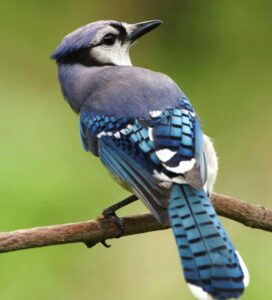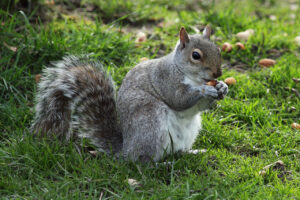We humans can be smug about our intelligence. One definition of intelligence is the ability to successfully cope with reality. By that definition, every animal species has its own intelligence edge. After all, when’s the last time you saw a person build a nest out of twigs and saliva, which is all in a day’s work for a chimney swift?
But even within this framework, some species of Ohio wildlife are smart in ways that seem eerily familiar, maybe even almost… human. Studies have shown that many animals are smarter than we’ve given them credit for. Read on to learn how three wild creatures scheme, keep secrets, hold grudges, and generally behave like they’d be right at home in a Shakespeare play.
Raccoons
 Every night, in backyards and alleyways across the country, a battle is waged. With their flexible minds, dexterous paws, and willingness to eat anything, raccoons treat our garbage cans and bird feeders as puzzles to be solved. And so far, the raccoons are winning. In an episode of Nature , Ohio wildlife biologist Stan Gehrt notes the “wide repertoire” of raccoon behaviors, which are impossible to fully catalog with a single study of one group of raccoons, when just miles away another group might have its own collection of food-finding and survival strategies. Raccoons are constantly evolving new means of accessing our tasty trash.
Every night, in backyards and alleyways across the country, a battle is waged. With their flexible minds, dexterous paws, and willingness to eat anything, raccoons treat our garbage cans and bird feeders as puzzles to be solved. And so far, the raccoons are winning. In an episode of Nature , Ohio wildlife biologist Stan Gehrt notes the “wide repertoire” of raccoon behaviors, which are impossible to fully catalog with a single study of one group of raccoons, when just miles away another group might have its own collection of food-finding and survival strategies. Raccoons are constantly evolving new means of accessing our tasty trash.
In fact, our efforts to dissuade these wily omnivores may actually be helping their development. The raccoon population has exploded in cities, with some studies finding that their population is 20 times denser in urban than in rural environments. And as quickly as we are devising new contraptions for keeping them out of our trashcans and homes, raccoons are figuring out how to thwart these efforts. In the Nature documentary, scientists speculate that by driving changes in raccoon behavior, we are changing the structure of their brain. In other words, we’re making them smarter. Is this The Planet of the Raccoons in the making?
Corvids
 Members of the corvid family include crows, ravens and blue jays, and they are watching you. One study found that crows recognize individual human faces, even holding grudges against particular people that persist for years and are shared among flock members and passed from parent to young crow.
Members of the corvid family include crows, ravens and blue jays, and they are watching you. One study found that crows recognize individual human faces, even holding grudges against particular people that persist for years and are shared among flock members and passed from parent to young crow.
A study of scrub jays, a corvid species, suggests they are capable of imagining what others are thinking. Jays who were accomplished thieves would return to move stashes of food that they’d first hidden while being observed, thus hinting that they were able to project their own thieving behavior onto the motives of another (jays who were not thieves did not re-hide their food supply).
Making improvements to previously developed tools was once viewed as distinctly human; even chimpanzees were only recently observed to do this. Crows, however, have been found to develop new features in the insect-capturing tools they fashion out of leaves, passing these discoveries on to later generations.
As for what powers their exceptional intelligence, it has been suggested that corvids engage in imitative learning, a complex form of learning that demands the learner translate what it sees into its own behavior. The next time you encounter a crow, watch out: it may be learning something from you.
Squirrels
 Corvids are not the only creatures in your neighborhood suspicious of their peers. One study of gray squirrels found that squirrels hiding nuts were more cautious when they knew they were being watched. Like kids stashing their preferred Halloween candies away from the prying hands of siblings, squirrels were even more careful when hiding their favorite nuts.
Corvids are not the only creatures in your neighborhood suspicious of their peers. One study of gray squirrels found that squirrels hiding nuts were more cautious when they knew they were being watched. Like kids stashing their preferred Halloween candies away from the prying hands of siblings, squirrels were even more careful when hiding their favorite nuts.
Squirrels also keep a mental inventory of where they’ve buried their food, as shown by a study that allowed several squirrels to bury nuts throughout an area. After delays of two, four or twelve days, squirrels were released back into the area, where they were more likely to uncover their own nuts than they were to sniff out the nuts of their peers. The squirrels also rarely retraced their steps when moving from one location to the next, suggesting that they formed mental maps of where they’d hidden food and decided on the most efficient ways to retrieve it. (People running errands, take note!)
Another study found that squirrels can quickly outsmart a shell game, in which food is hidden under one of two pots, but they don’t learn quickly when they are trained with the use of cards. The study shows that squirrels learn from observation, and that they are a fast study when it comes to the thing that is important to them: nuts!
Of course, crows, raccoons and squirrels are not the only brainy creatures out there—recent studies have uncovered previously unknown mental powers in a wide variety of animals, including dogs, chickens and even fish. We’re surrounded by intelligent creatures, so keep this in mind the next time you spot one while on a walk—it may know more about you than you think!
– Meredith Southard
